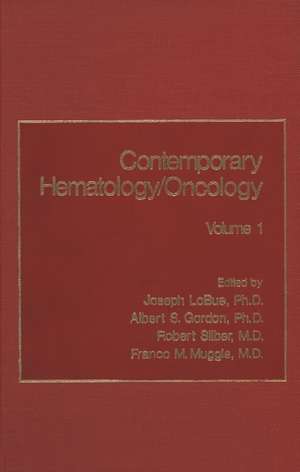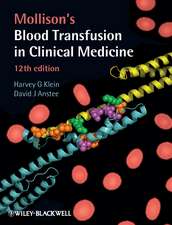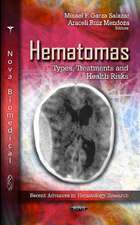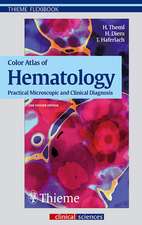Contemporary Hematology/Oncology: Volume 1
Editat de Albert S. Gordonen Limba Engleză Paperback – iun 2012
Preț: 717.73 lei
Preț vechi: 755.51 lei
-5% Nou
Puncte Express: 1077
Preț estimativ în valută:
137.34€ • 143.75$ • 114.31£
137.34€ • 143.75$ • 114.31£
Carte tipărită la comandă
Livrare economică 31 martie-14 aprilie
Preluare comenzi: 021 569.72.76
Specificații
ISBN-13: 9781468435771
ISBN-10: 1468435779
Pagini: 348
Ilustrații: XVI, 330 p. 32 illus.
Dimensiuni: 152 x 229 x 18 mm
Greutate: 0.47 kg
Ediția:Softcover reprint of the original 1st ed. 1980
Editura: Springer Us
Colecția Springer
Locul publicării:New York, NY, United States
ISBN-10: 1468435779
Pagini: 348
Ilustrații: XVI, 330 p. 32 illus.
Dimensiuni: 152 x 229 x 18 mm
Greutate: 0.47 kg
Ediția:Softcover reprint of the original 1st ed. 1980
Editura: Springer Us
Colecția Springer
Locul publicării:New York, NY, United States
Public țintă
ResearchDescriere
The continuous advances in our understanding of hematology and neo plastic disorders have made possible this third volume of reviews. Their purpose is to summarize investigations which have defined new concepts, and, it is hoped, stimulate new ideas. In the choice of subjects, we have attempted to retain the balance between academic and clinical interests. We are grateful to the contributors, who have maintained the high stan dards set in the earlier volumes, and for feedback from readers. Both have helped to orient the direction of this series. It was a reader who pointed out that the title of the two earlier volumes, The Year in Hematol ogy, was misleading since it suggested a detailed review of trends and findings limited to the last year. In response to this valid comment, The Year . . . has been changed to Contemporary . . . and the scope has been expanded to encompass the kindred disciplines of hematology and oncol ogy. Another editor, Franco M. Muggia, has been added to provide addi tional expertise for the latter field. The title of the present and future volumes has been changed to Contemporary Hematology/Oncology. It has been pointed out to us that considerable ingenuity will be needed to find topics not already covered. We believe that the papers in the present volume have met this challenge. As before, the readers' comments con cerning Contemporary Hematology/Oncology will be appreciated. Joseph LoBue Albert S. Gordon Robert Silber Franco M.
Cuprins
1 Clonal and Stem Cell Origin of Blood Cell Neoplams.- 1.1. Introduction.- 1.2. Mosaic Systems.- 1.2.1. X-Chromosome Inactivation Mosaicism.- 1.2.2. G6PD Markers.- 1.3. Myeloproliferative Disorders.- 1.3.1. Chronic Myelogenous Leukemia.- 1.3.2. Polycythemia Vera.- 1.3.3. Agnogenic Myeloid Metaplasia with Myelofibrosis.- 1.4. Miscellaneous Myeloid Cell Disorders.- 1.4.1. Paroxysmal Nocturnal Hemoglobinuria.- 1.4.2. Sideroblastic Anemia.- 1.5. Blood Cell Lymphoproliferative Neoplasms.- 1.5.1. Immunoglobulin Mosaicism.- 1.5.2. Chronic Lymphocytic Leukemia.- 1.5.3. Plasma Cell Neoplasms.- 1.5.4. Waldenstrom Macroglobulinemia.- 1.5.5. Idiopathic Cold Agglutinin Disease.- 1.6. Lymphoma.- 1.6.1. Burkitt Lymphoma.- 1.6.2. Other B-Cell Lymphomas.- 1.7. Acute Leukemia.- 1.7.1. Acute Lymphoblastic Leukemia.- 1.7.2. Acute Nonlymphoblastic Leukemia.- 1.7.3. Posttransplantation Recurrences of Acute Leukemia.- 1.8. Summary and Concluding Remarks.- 1.8.1. Pluripotent Stem Cell Origin.- 1.8.2. Clonal Origin.- 1.8.3. Pathogenic Implications.- 1.8.4. Diagnostic and Therapeutic Implications.- 1.8.5. Recurrences.- 1.8.6. Second Malignancies in Patients with Chronic Hematopoietic Neoplasms.- 1.8.7. Future Studies.- References.- 2 Interactions of Vessel Wall with Formed Blood Elements.- 2.1. Introduction.- 2.2. Thrombus Formation within the Blood Vessel.- 2.2.1. Blood Flow.- 2.3. The Blood Vessel.- 2.3.1. Endothelial Cells.- 2.3.2. The Subendothelial Zone.- 2.4. Thrombosis on the Subendothelium.- 2.4.1. The Media and Smooth Muscle Cell.- 2.4.2. Adventitia.- 2.5. Endothelial Damage.- 2.6. The Platelet Response.- 2.7. Vascular Response to the Hemostatic Mechanism.- 2.8. Hypercoagulability and Atherogenesis.- 2.9. The Endothelium and Atherogenesis.- 2.10. Control of the Lesion.- 2.11. Summary.- References.- 3 The Effect of Heparin upon Complement Activation.- 3.1. Introduction.- 3.1.1. Pharmacology of Heparin.- 3.1.2. Mechanism of Complement Activation.- 3.1.3. Role of Complement Activation in Human Diseases.- 3.2. Heparin as a Complement Inhibitor.- 3.2.1. Historical Aspects.- 3.2.2. Heparin and the Classic Complement Pathway.- 3.2.3. Heparin and the Alternative Pathway.- 3.2.4. Heparin and the Final Common Complement Pathway.- 3.3. Clinical Implications.- 3.3.1. Paroxysmal Nocturnal Hemoglobinuria.- 3.3.2. Immune Hemolytic Anemia.- 3.3.3. Hypocomplementemic Glomerulonephritis.- 3.3.4. Hereditary Angioneurotic Edema.- 3.3.5. Interaction between Complement and Human Granulocytes.- 3.4. Summary.- References.- 4 The Molecular Genetics of Thalassemia.- 4.1. Introduction.- 4.2. The Thalassemias: The Range of Potential Molecular Defects.- 4.3. Globin Gene Expression.- 4.3.1. Biogenesis, Metabolism, and Structure of Globin Messenger RNAs.- 4.3.2. In Vitro Globin Gene Expression and Chromatin Structure.- 4.4. The Organization of Eukaryotic Genes.- 4.5. The Organization of Globin Genes in Human DNA.- 4.6. Molecular Defects in Thalassemia Syndromes.- 4.6.1. Deletion of Globin Structural Genes.- 4.6.2. Gene Deletion Associated with Abnormal Globin Chains.- 4.6.3. State of the ß Globin Gene in ?0-Thalassemias.- 4.6.4. Nondeletion Thalassemic Defects in Globin Genes.- 4.6.5. Abnormal Globin Messenger RNAs in Thalassemias.- 4.7. Conclusions and Future Prospects.- References.- 5 Blood Group Alterations in Cancer.- 5.1. Introduction.- 5.2. Blood Groups: An Overview.- 5.2.1. Blood Group Serology: Techniques of Antigen Detection and Quantitation.- 5.2.2. Genetic Aspects.- 5.2.3. Blood Group Structure and Biosynthesis.- 5.3. Serologic Studies of Blood Groups in Malignancy.- 5.3.1. Associations of Blood Groups with Cancer.- 5.3.2. Loss of Erythrocytic Blood Groups in Leukemia.- 5.3.3. Alterations of Tissue Blood Group Antigens in Carcinoma.- 5.3.4. Other Malignancies.- 5.3.5. Naturally Occurring Blood Group Agglutinins—Loss in Malignancy.- 5.4. Immunologic Effects of Tumor-Associated Blood Group Alterations.- 5.5. Studies of Cellular Blood Group Structure and Biosynthesis in Malignancy.- 5.5.1. Abnormalities of Cellular Blood Group Glycoconjugates.- 5.5.2. Deficient Production of Glycosyltransferase Enzymes.- 5.5.3. Masking of Antigens by Excessive Neuraminic Acid.- 5.5.4. Relationships of Blood Groups to Carcinoembryonic Antigen.- 5.6. Studies of Blood Groups on Cultured Transformed Cells and Cell-Cell Hybrids: Structure-Function Relationships.- 5.6.1. Relationships of H-Gene-Specified ?-2-Fucosyltransferase and H-Antigen Expression to Growth Patterns of HeLa Cells.- 5.6.2. Cell-Cell Hybrids for Studies of Blood Group Alteration.- 5.6.3. In Vitro Approaches to Structure-Function Relationships of Blood Group Antigens.- 5.7. Discussion.- 5.8. Summary.- References.- 6 Rational Approach to Granulocyte Transfusion Therapy.- 6.1. Introduction.- 6.2. Granulocyte Collection.- 6.2.1. Differential Centrifugation Leukopheresis.- 6.2.2. Filtration Leukopheresis.- 6.3. Therapeutic Granulocyte Transfusion.- 6.4. Histocompatibility Testing.- 6.5. Prophylactic Granulocyte Transfusion.- 6.6. Future Research Methodology.- References.- 7 Mechanisms and Functions of Capping in Lymphocytes.- 7.1. Introduction.- 7.2. Surface Immunoglobulin on B Cells.- 7.3. Kinetics and Pharmacology of sIg Capping.- 7.4. Capping and Cell Motility.- 7.5. Events after Capping.- 7.6. Capping of Other Molecules and Cells.- 7.7. Capping and Membrane Structure: The Fluid Mosaic Model.- 7.8. Capping and the Immune Response.- 7.9. Capping Induced by Antigen.- 7.10. Capping and Chemotaxis.- 7.11. Abnormalities of Capping and Motility.- References.- 8 Amyloidosis.- 8.1. Introduction.- 8.2. Pathology.- 8.2.1. Gross Appearance.- 8.2.2. Tinctorial Properties.- 8.2.3. Light Microscopic Appearance.- 8.2.4. Ultrastructure.- 8.3. Biochemistry of Amyloid.- 8.4. Pathogenesis.- 8.4.1. Secondary, Transfer, and Age-Associated Amyloidosis.- 8.4.2. Serum Amyloid Precursors.- 8.4.3. Immunoregulatory Dysfunction Amyloidosis.- 8.4.4. Macrophages and Bone Marrow Dysfunction.- 8.5. Clinical Aspects.- 8.5.1. Diagnosis.- 8.5.2. General Clinical Manifestations.- 8.5.3. Prognosis.- 8.5.4. Treatment.- References.- 9 The Significance of Terminal Transferase in Normal and Neoplastic Hematopoietic Cells.- 9.1. Introduction.- 9.2. Original Discovery and Biochemistry of TdT.- 9.3. Discovery of TdT in Human Leukemia Cells.- 9.4. Procedures for the Assay of TdT.- 9.5. Characteristics of TdT-Positive Human Leukemias.- 9.6. Significance of TdT in Leukemia Cells.- 9.7. TdT in Leukemia-in-Remission.- 9.8. TdT in Malignant Lymphomas.- 9.9. TdT in Murine Leukemias.- 9.10. Anatomy and Physiology of Normally Occurring TdT-Positive Cells.- References.- 10 Kinin-Releasing Mechanisms in Hemostasis.- 10.1. Introduction.- 10.2. Kinin Release.- 10.3. Surface-Initiated Blood Clotting.- 10.4. Kinin-Releasing Mechanisms and Blood Clotting.- 10.5. The Clot-Promoting Actions of Kinin-Releasing Substances.- 10.6. Prekallikrein: Fletcher Factor.- 10.7. Kininogens and Clotting.- 10.8. Nature of Plasma Kininogens.- 10.9. High-Molecular-Weight Kininogen and Hageman-Factor-Dependent Reactions.- 10.10. What Is Activated Hageman Factor?.- 10.11. Bovine High-Molecular-Weight Kininogen.- 10.12. Kinin-Releasing Mechanisms and Fibrinolysis.- 10.13. The Role of Kinin-Releasing Mechanisms in Collaborative Actions between Intrinsic and Extrinsic Clotting Mechanisms.- 10.14. Concluding Remarks.- References.







